The Peak Metamorphic P–T Conditions of the Sanbagawa Schists in the Shibukawa Area, Central Japan: Application of Raman Geothermobarometry
Abstract
1. Introduction
2. Geological Background
3. Sample Descriptions
3.1. Mafic Schists
3.2. Pelitic Schists
3.3. Siliceous and Psammitic Schists
4. Mineral Chemistry
5. Raman Spectroscopy
5.1. Raman Carbonaceous Material Geothermometry
5.2. Raman Geobarometry
6. Discussion
6.1. Metamorphic Thermal Structure
6.2. Metamorphic Pressure
6.3. Comparison with Metamorphic Index Minerals
6.4. Comparison with Other Regions
7. Conclusions
- (1)
- The Sanbagawa schists in the Shibukawa area, central Japan, show peak metamorphic temperature values of 307 ± 27 °C to 395 ± 16 °C with Raman CM geothermometry, which increase from the southeast towards the MTL. This trend is consistent with the occurrence of temperature-sensitive metamorphic minerals.
- (2)
- A garnet-bearing siliceous schist underwent Raman geobarometry using a quartz-inclusion-in-spessartine system. In combination with the temperature of the nearby pelitic schist sample, a peak P–T condition of 0.78–0.94 GPa at 360–390 °C was derived. This condition is similar to the peak pressure condition of the garnet zone in central Shikoku.
Author Contributions
Funding
Data Availability Statement
Acknowledgments
Conflicts of Interest
Abbreviations
| CM | Carbonaceous material |
| EPMA | Electron probe microanalyzer |
| MTL | Median Tectonic Line |
| P–T | pressure–temperature |
Appendix A. Residual Pressure Estimation

| Sample | ∆ν464 (cm−1) | ∆ν205 (cm−1) | ∆ν127 (cm−1) | ∆ω1 (cm−1) | Pi∆ω1 (GPa) | Pi∆ν464 (GPa) | Pi∆ν205 (GPa) | |Pi∆ν464−Pi∆ν205| (GPa) | ε1 + ε2 | ε3 | Pistrains (GPa) |
|---|---|---|---|---|---|---|---|---|---|---|---|
| SS020218_Grt2_Qz1 | 3.30 | 9.89 | 2.29 | 6.59 | 0.33 | 0.37 | 0.36 | 0.01 | −0.014 (4) | 0.001 (2) | 0.37 |
| SS020218_Grt5_Qz1 | 3.43 | 10.73 | 2.34 | 7.30 | 0.37 | 0.38 | 0.39 | 0.01 | −0.017 (4) | 0.002 (2) | 0.42 |
| SS020218_Grt5_Qz2 | 3.44 | 10.36 | 2.48 | 6.92 | 0.35 | 0.39 | 0.38 | 0.01 | −0.014 (4) | 0.000 (3) | 0.40 |
| SS020218_Grt7_Qz1 | 3.11 | 9.30 | 1.76 | 6.19 | 0.30 | 0.35 | 0.33 | 0.02 | −0.0149 (8) | 0.0018 (5) | 0.37 |
| SS020218_Grt9_Qz2 | 2.57 | 9.39 | 1.66 | 6.82 | 0.34 | 0.29 | 0.34 | 0.05 | −0.019 (3) | 0.0044 (20) | 0.39 |
| SS020218_Grt9_Qz3 | 3.34 | 10.21 | 2.31 | 6.87 | 0.35 | 0.37 | 0.37 | 0.00 | −0.015 (4) | 0.001 (2) | 0.40 |
| SS020218_Grt10_Qz1 | 3.37 | 10.28 | 2.52 | 6.91 | 0.35 | 0.38 | 0.37 | 0.01 | −0.014 (5) | 0.000 (3) | 0.40 |
| SS020218_Grt10_Qz2 | 3.23 | 10.25 | 2.22 | 7.02 | 0.36 | 0.36 | 0.37 | 0.01 | −0.016 (4) | 0.002 (2) | 0.39 |
| SS020218_Grt10_Qz3 | 3.34 | 10.11 | 2.31 | 6.77 | 0.34 | 0.37 | 0.37 | 0.00 | −0.014 (4) | 0.001 (2) | 0.37 |
| SS020218_Grt14_Qz1 | 3.45 | 9.97 | 2.82 | 6.52 | 0.32 | 0.39 | 0.36 | 0.03 | −0.011 (6) | −0.002 (4) | 0.39 |
| SS020218_Grt15_Qz1 | 2.43 | 8.48 | 1.63 | 6.05 | 0.29 | 0.27 | 0.30 | 0.03 | −0.016 (3) | 0.0031 (20) | 0.35 |
| SS020218_Grt18_Qz1 | 1.63 | 7.81 | 1.22 | 6.18 | 0.30 | 0.18 | 0.28 | 0.10 | −0.019 (4) | 0.006 (3) | 0.34 |
| SS020218_Grt18_Qz2 | 3.40 | 9.70 | 2.54 | 6.30 | 0.31 | 0.38 | 0.35 | 0.03 | −0.011 (5) | −0.001 (3) | 0.35 |
| SS020218_Grt18_Qz3 | 3.18 | 10.42 | 2.54 | 7.24 | 0.37 | 0.36 | 0.38 | 0.02 | −0.016 (6) | 0.001 (4) | 0.43 |
| Standard | ν464 (cm−1) | ν205 (cm−1) | ν127 (cm−1) | ω1 (cm−1) | |||||||
| 12/10/2021 | 464.44 | 206.01 | 127.64 | 258.43 | |||||||
| 30/11/2021 | 464.33 | 205.83 | 127.41 | 258.50 | |||||||
| 07/12/2021 | 463.90 | 205.35 | 126.81 | 258.55 |
References
- Bourdelle, F. Low-Temperature Chlorite Geothermometry and Related Recent Analytical Advances: A Review. Minerals 2021, 11, 130. [Google Scholar] [CrossRef]
- Petroccia, A.; Forshaw, J.B.; Lanari, P.; Iaccarino, S.; Montomoli, C.; Carosi, R. Pressure and Temperature Estimation in Greenschist-Facies Metapelites: An Example From Variscan Belt in Sardinia. J. Metamorph. Geol. 2025, 43, 21–46. [Google Scholar] [CrossRef]
- Wallis, S.R.; Okudaira, T. Paired metamorphic belts of SW Japan: The geology of the Sanbagawa and Ryoke metamorphic belts and the Median Tectonic Line. In The Geology of Japan; Moreno, T., Wallis, S.R., Kojima, T., Gibbons, W., Eds.; Geological Society: London, UK, 2016; pp. 101–124. [Google Scholar]
- Aoya, M. P–T–D Path of Eclogite from the Sambagawa Belt Deduced from Combination of Petrological and Microstructural Analyses. J. Petrol. 2001, 42, 1225–1248. [Google Scholar] [CrossRef]
- Endo, S.; Wallis, S.R.; Hirata, T.; Anczkiewicz, R.; Platt, J.P.; Thirlwall, M.; Asahara, Y. Age and early metamorphic history of the Sanbagawa belt: Lu–Hf and P–T constraints from the Western Iratsu eclogite. J. Metamorph. Geol. 2009, 27, 371–384. [Google Scholar] [CrossRef]
- Wallis, S.; Aoya, M. A re-evaluation of eclogite facies metamorphism in SW Japan: Proposal for an eclogite nappe. J. Metamorph. Geol. 2000, 18, 653–664. [Google Scholar] [CrossRef]
- Higashino, T. The higher grade metamorphic zonation of the Sambagawa metamorphic belt in central Shikoku, Japan. J. Metamorph. Geol. 1990, 8, 413–423. [Google Scholar] [CrossRef]
- Aoya, M.; Kouketsu, Y.; Endo, S.; Shimizu, H.; Mizukami, T.; Nakamura, D.; Wallis, S. Extending the applicability of the Raman carbonaceous-material geothermometer using data from contact metamorphic rocks. J. Metamorph. Geol. 2010, 28, 895–914. [Google Scholar] [CrossRef]
- Beyssac, O.; Goffé, B.; Chopin, C.; Rouzaud, J.N. Raman spectra of carbonaceous material from metasediments: A new geothermometer. J. Metamorph. Geol. 2002, 20, 859–871. [Google Scholar] [CrossRef]
- Kouketsu, Y.; Mizukami, T.; Mori, H.; Endo, S.; Aoya, M.; Hara, H.; Nakamura, D.; Wallis, S. A new approach to develop the Raman carbonaceous material geothermometer for low-grade metamorphism using peak width. Isl. Arc 2014, 23, 33–50. [Google Scholar] [CrossRef]
- Angel, R.J.; Alvaro, M.; Miletich, R.; Nestola, F. A simple and generalised P–T–V EoS for continuous phase transitions, implemented in EosFit and applied to quartz. Contrib. Mineral. Petrol. 2017, 172, 29. [Google Scholar] [CrossRef]
- Enami, M.; Nishiyama, M.; Mouri, T. Laser Raman microspectrometry of metamorphic quartz: A simple method for comparison of metamorphic pressures. Am. Mineral. 2007, 92, 1303–1315. [Google Scholar] [CrossRef]
- Morana, M.; Mihailova, B.; Angel, R.J.; Alvaro, M. Quartz metastability at high pressure: What new can we learn from polarized Raman spectroscopy? Phys. Chem. Miner. 2020, 47, 34. [Google Scholar] [CrossRef]
- Kouketsu, Y.; Nishiyama, T.; Ikeda, T.; Enami, M. Evaluation of residual pressure in an inclusion-host system using negative frequency shift of quartz Raman spectra. Am. Mineral. 2014, 99, 433–442. [Google Scholar] [CrossRef]
- Makimoto, H.; Yamada, N.; Mizuno, K.; Takada, A.; Komazawa, M.; Sudo, S. Geological Map of Japan 1: 200,000, Toyohashi and Irago Misaki; Geological Survey of Japan; AIST: Tsukuba, Japan, 2004; (In Japanese with English Abstract). [Google Scholar]
- Miyashiro, A. Metamorphism and related magmatism in plate tectonics. Am. J. Sci. 1972, 272, 629–656. [Google Scholar] [CrossRef]
- Banno, S.; Sakai, C. Geology and metamorphic evolution of the Sanbagawa metamorphic belt, Japan. Geol. Soc. Lond. Spec. Publ. 1989, 43, 519–532. [Google Scholar] [CrossRef]
- Goto, M. The geology of the Sambagawa belt in the River Tenryu district, Shizuoka Prefecture. In Tectonics and Metamorphism (The Hara Volume); Shimamoto, T., Hayasaka, Y., Shiota, T., Oda, M., Takeshita, T., Yokoyama, S., Ohtomo, Y., Eds.; Soubun Co., Ltd.: Tokyo, Japan, 1996; pp. 70–77, (In Japanese with English Abstract). [Google Scholar]
- Tagiri, M.; Yago, Y.; Tanaka, A. Shuffled-cards structure and different P/T conditions in the Sanbagawa metamorphic belt, Sakuma-Tenryu area, central Japan. Isl. Arc 2000, 9, 188–203. [Google Scholar] [CrossRef]
- Endo, S.; Wallis, S.R. Structural architecture and low-grade metamorphism of the Mikabu-Northern Chichibu accretionary wedge. J. Metamorph. Geol. 2017, 35, 695–716. [Google Scholar] [CrossRef]
- Mouri, K.; Enami, M. Chemical compositions of minerals from the Kichijosan and Joyama complexes in the Sanbagawa metamorphic belt, central Japan. Bull. Nagoya Univ. Mus. (Furukawa Mus.) 1988, 4, 15–30, (In Japanese with English Abstract). [Google Scholar]
- Shioya, H.; Michibayashi, K.; Kouketsu, Y.; Enami, M. Reconfirmation of jadeite in the Sanbagawa belt of the Shibukawa region, central Japan: Occurrence within a veinlet cutting dunite. J. Geol. Soc. Jpn. 2021, 127, 59–65, (In Japanese with English Abstract). [Google Scholar] [CrossRef]
- Seki, Y.; Aiba, M.; Kato, C. Metamorphic zoning of the Sanbagawa terrain in the Sibukawa district, central Japan. J. Geol. Soc. Jpn. 1959, 65, 618–623, (In Japanese with English Abstract). [Google Scholar] [CrossRef]
- Isogai, K. The Sambagawa Metamorphism in the Westernpart of Central Japan. In Sambagawa Belt; Hide, K., Ed.; Hiroshima University Press: Hiroshima, Japan, 1977; pp. 237–245, (In Japanese with English Abstract). [Google Scholar]
- Warr, L.N. IMA–CNMNC approved mineral symbols. Mineral. Mag. 2021, 85, 291–320. [Google Scholar] [CrossRef]
- Locock, A.J. An Excel spreadsheet to recast analyses of garnet into end-member components, and a synopsis of the crystal chemistry of natural silicate garnets. Comput. Geosci. 2008, 34, 1769–1780. [Google Scholar] [CrossRef]
- French, B.M. Graphitization of organic material in a progressively metamorphosed Precambrian iron formation. Science 1964, 146, 917–918. [Google Scholar] [CrossRef]
- Tagiri, M. A measurement of the graphitizing-degree by the X-ray powder diffractometer. J. Jpn. Assoc. Mineral. Petrol. Econ. Geol. 1981, 76, 345–352. [Google Scholar] [CrossRef]
- Mori, K.; Taguchi, K. Examination of the low-grade metamorphism in the Shimanto Belt by vitrinite reflectance. Mod. Geol. 1988, 12, 325–339. [Google Scholar]
- Kouketsu, Y.; Sadamoto, K.; Umeda, H.; Kawahara, H.; Nagaya, T.; Taguchi, T.; Mori, H.; Wallis, S.; Enami, M. Thermal structure in subducted units from continental Moho depths in a paleo subduction zone, the Asemigawa region of the Sanbagawa metamorphic belt, SW Japan. J. Metamorph. Geol. 2021, 39, 727–749. [Google Scholar] [CrossRef]
- Skrzypek, E. First- and second-order Raman spectra of carbonaceous material through successive contact and regional metamorphic events (Ryoke belt, SW Japan). Lithos 2021, 388–389, 106029. [Google Scholar] [CrossRef]
- Ferrari, A.C.; Robertson, J. Interpretation of Raman spectra of disordered and amorphous carbon. Phys. Rev. B 2000, 61, 95–107. [Google Scholar] [CrossRef]
- Lahfid, A.; Beyssac, O.; Deville, E.; Negro, F.; Chopin, C.; Goffé, B. Evolution of the Raman spectrum of carbonaceous material in low-grade metasediments of the Glarus Alps (Switzerland). Terra Nova 2010, 22, 354–360. [Google Scholar] [CrossRef]
- Tuinstra, F.; Koenig, J.L. Raman spectrum of graphite. J. Chem. Phys. 1970, 53, 1126–1130. [Google Scholar] [CrossRef]
- Angel, R.J.; Nimis, P.; Mazzucchelli, M.L.; Alvaro, M.; Nestola, F. How large are departures from lithostatic pressure? Constraints from host–inclusion elasticity. J. Metamorph. Geol. 2015, 33, 801–813. [Google Scholar] [CrossRef]
- Bonazzi, M.; Tumiati, S.; Thomas, J.B.; Angel, R.J.; Alvaro, M. Assessment of the reliability of elastic geobarometry with quartz inclusions. Lithos 2019, 350–351, 105201. [Google Scholar] [CrossRef]
- Thomas, J.B.; Spear, F.S. Experimental study of quartz inclusions in garnet at pressures up to 3.0 GPa: Evaluating validity of the quartz-in-garnet inclusion elastic thermobarometer. Contrib. Mineral. Petrol. 2018, 173, 1–14. [Google Scholar] [CrossRef]
- Angel, R.J.; Murri, M.; Mihailova, B.; Alvaro, M. Stress, strain and Raman shifts. Z. Krist. Cryst Mater. 2019, 234, 129–140. [Google Scholar] [CrossRef]
- Mazzucchelli, M.L.; Burnley, P.; Angel, R.J.; Morganti, S.; Domeneghetti, M.C.; Nestola, F.; Alvaro, M. Elastic geothermobarometry: Corrections for the geometry of the host-inclusion system. Geology 2018, 46, 231–234. [Google Scholar] [CrossRef]
- Zhong, X.; Moulas, E.; Tajčmanová, L. Post-entrapment modification of residual inclusion pressure and its implications for Raman elastic thermobarometry. Solid Earth 2020, 11, 223–240. [Google Scholar] [CrossRef]
- Tomioka, Y.; Kouketsu, Y.; Taguchi, T. Raman geobarometry of quartz inclusions in kyanite: Application to quartz eclogite from the Gongen Area of the Sanbagawa Belt, Southwest Japan. Can. Mineral. 2022, 60, 121–132. [Google Scholar] [CrossRef]
- Schmidt, C.; Ziemann, M.A. In-situ Raman spectroscopy of quartz: A pressure sensor for hydrothermal diamond-anvil cell experiments at elevated temperatures. Am. Mineral. 2000, 85, 1725–1734. [Google Scholar] [CrossRef]
- Mori, H.; Wallis, S.; Fujimoto, K.; Shigematsu, N. Recognition of shear heating on a long-lived major fault using Raman carbonaceous material thermometry: Implications for strength and displacement history of the MTL, SW Japan. Isl. Arc 2015, 24, 425–446. [Google Scholar] [CrossRef]
- Mori, H.; Wallis, S. Large-scale folding in the Asemi-gawa region of the Sanbagawa Belt, southwest Japan. Isl. Arc 2010, 19, 357–370. [Google Scholar] [CrossRef]
- Shimura, Y.; Tokiwa, T.; Mori, H.; Takeuchi, M.; Kouketsu, Y. Deformation characteristics and peak temperatures of the Sanbagawa Metamorphic and Shimanto Accretionary complexes on the central Kii Peninsula, SW Japan. J. Asian Earth Sci. 2021, 215, 104791. [Google Scholar] [CrossRef]
- Enami, M.; Wallis, S.; Banno, Y. Paragenesis of sodic pyroxene-bearing quartz schists: Implications for the P-T history of the Sanbagawa belt. Contrib. Mineral. Petrol. 1994, 116, 182–198. [Google Scholar] [CrossRef]
- Toriumi, M. Metamorphism of the Southern Kanto Mountains—Its Pressure Condition. In Sambagawa Belt; Hide, K., Ed.; Hiroshima University Press: Hiroshima, Japan, 1977; pp. 217–221, (In Japanese with English Abstract). [Google Scholar]
- Angel, R.J.; Mazzucchelli, M.L.; Alvaro, M.; Nestola, F. EosFit-Pinc: A simple GUI for host-inclusion elastic thermobarometry. Am. Mineral. 2017, 102, 1957–1960. [Google Scholar] [CrossRef]
- Nestola, F.; Prencipe, M.; Nimis, P.; Sgreva, N.; Perritt, S.H.; Chinn, I.L.; Zaffiro, G. Toward a robust elastic geobarometry of kyanite inclusions in eclogitic diamonds. J. Geophys. Res. Solid Earth 2018, 123, 6411–6423. [Google Scholar] [CrossRef]
- Angel, R.J.; Gilio, M.; Mazzucchelli, M.; Alvaro, M. Garnet EoS: A critical review and synthesis. Contrib. Mineral. Petrol. 2022, 177, 54. [Google Scholar] [CrossRef]
- Hirajima, T. Mineralogy of a Fe-Mn rich nodule from the Sanbagawa schist in the Kanto Mountains, Japan. J. Geol. Soc. Jpn. 1989, 95, 817–833. [Google Scholar] [CrossRef]
- Holland, T.J.B.; Powell, R. An internally consistent thermodynamic data set for phases of petrological interest. J. Metamorph. Geol. 1998, 16, 309–343. [Google Scholar] [CrossRef]
- Evans, W.E. Phase relations of epidote-blueschists. Lithos 1990, 25, 3–23. [Google Scholar] [CrossRef]
- Aoya, M.; Endo, S. Recognition of the ‘early’ Sambagawa metamorphism and a schematic cross-section of the Late-Cretaceous Sambagawa subduction zone. J. Geol. Soc. Jpn. 2017, 123, 677–698, (In Japanese with English Abstract). [Google Scholar] [CrossRef]
- Manzotti, P.; Ballèvre, M.; Pitra, P.; Putlitz, B.; Robyr, M.; Müntener, O. The growth of sodic amphibole at the greenschist- to blueschist-facies transition (Dent Blanche, Western Alps): Bulk-rock chemical control and thermodynamic modelling. J. Petrol. 2020, 61, egaa044. [Google Scholar] [CrossRef]
- Iwasaki, M. Metamorphic rocks of the Kotu-bizan area, Eastern Sikoku. J. Fac. Sci. 1963, 15, 1–90. [Google Scholar]
- Aoya, M.; Uehara, S.; Matsumoto, M.; Wallis, S.R.; Enami, M. Subduction-stage pressure-temperature path of eclogite from the Sambagawa belt: Prophetic record for oceanic-ridge subduction. Geology 2003, 31, 1045–1048. [Google Scholar] [CrossRef]
- Endo, S.; Kouketsu, Y.; Aoya, M. Sanbagawa Subduction: What Went in, How Deep, and How Hot did it Get? Elements 2024, 20, 77–82. [Google Scholar] [CrossRef]
- Uehara, S.; Aoya, M. Thermal model for approach of a spreading ridge to subduction zones and its implications for high P/high T metamorphism: Importance of subduction vs. ridge-approach ratio. Tectonics 2005, 24, TC4007. [Google Scholar] [CrossRef]
- Wallis, S.R.; Anczkiewicz, R.; Endo, S.; Aoya, M.; Platt, J.P.; Thirlwall, M.; Hirata, T. Plate movements, ductile deformation and geochronology of the Sanbagawa belt, SW Japan: Tectonic significance of 89–88 Ma Lu–Hf eclogite ages. J. Metamorph. Geol. 2009, 27, 93–105. [Google Scholar] [CrossRef]
- Nye, J.F. Physical Properties of Crystals; Oxford University Press: Oxford, UK, 1957. [Google Scholar]
- Murri, M.; Alvaro, M.; Angel, R.J.; Prencipe, M.; Mihailova, B.D. The effects of non-hydrostatic stress on the structure and properties of alpha-quartz. Phys. Chem. Miner. 2019, 46, 487–499. [Google Scholar] [CrossRef]
- Wang, J.; Mao, Z.; Jiang, F.; Duffy, T.S. Elasticity of single-crystal quartz to 10 GPa. Phys. Chem. Miner. 2015, 42, 203–212. [Google Scholar] [CrossRef]
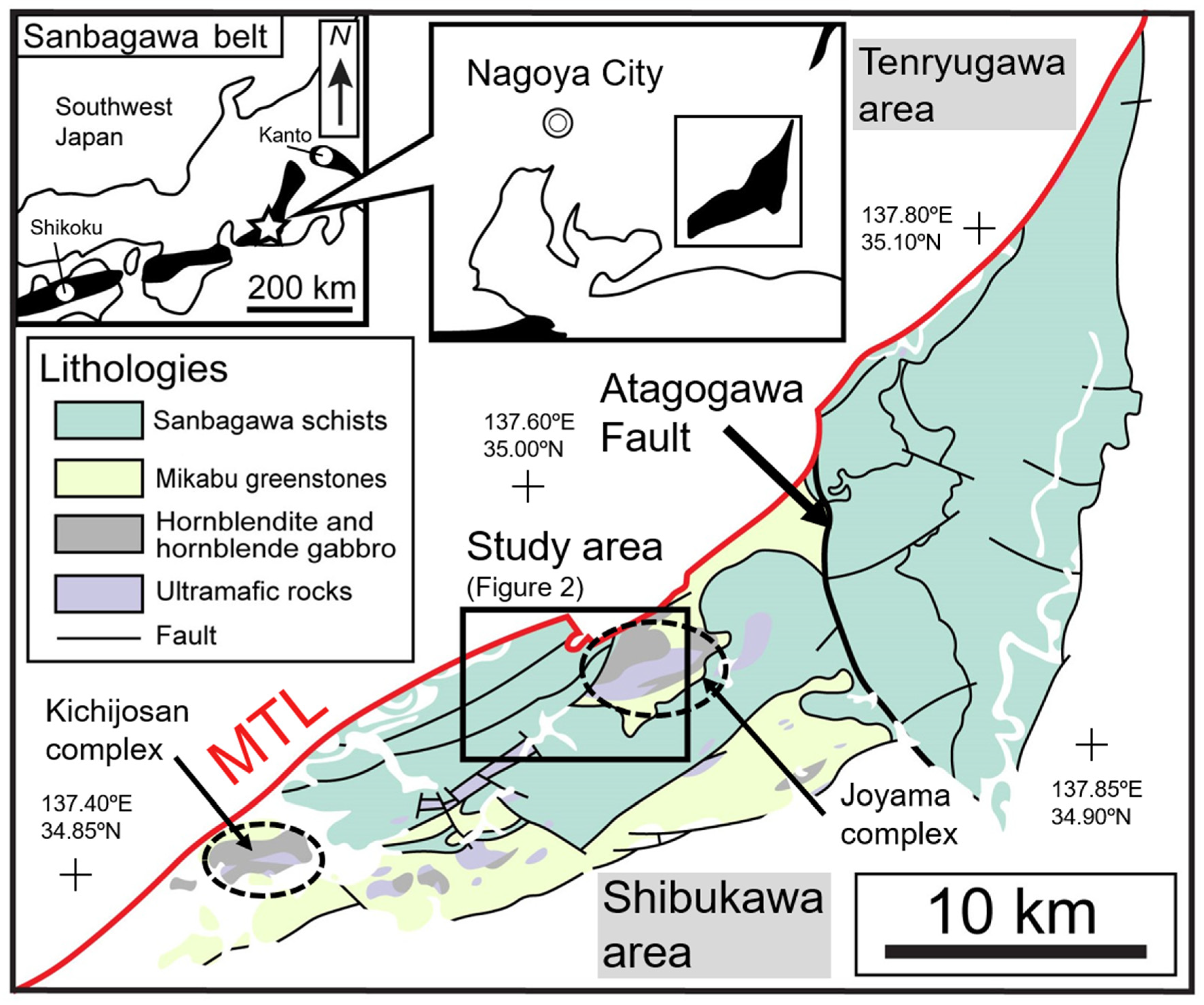
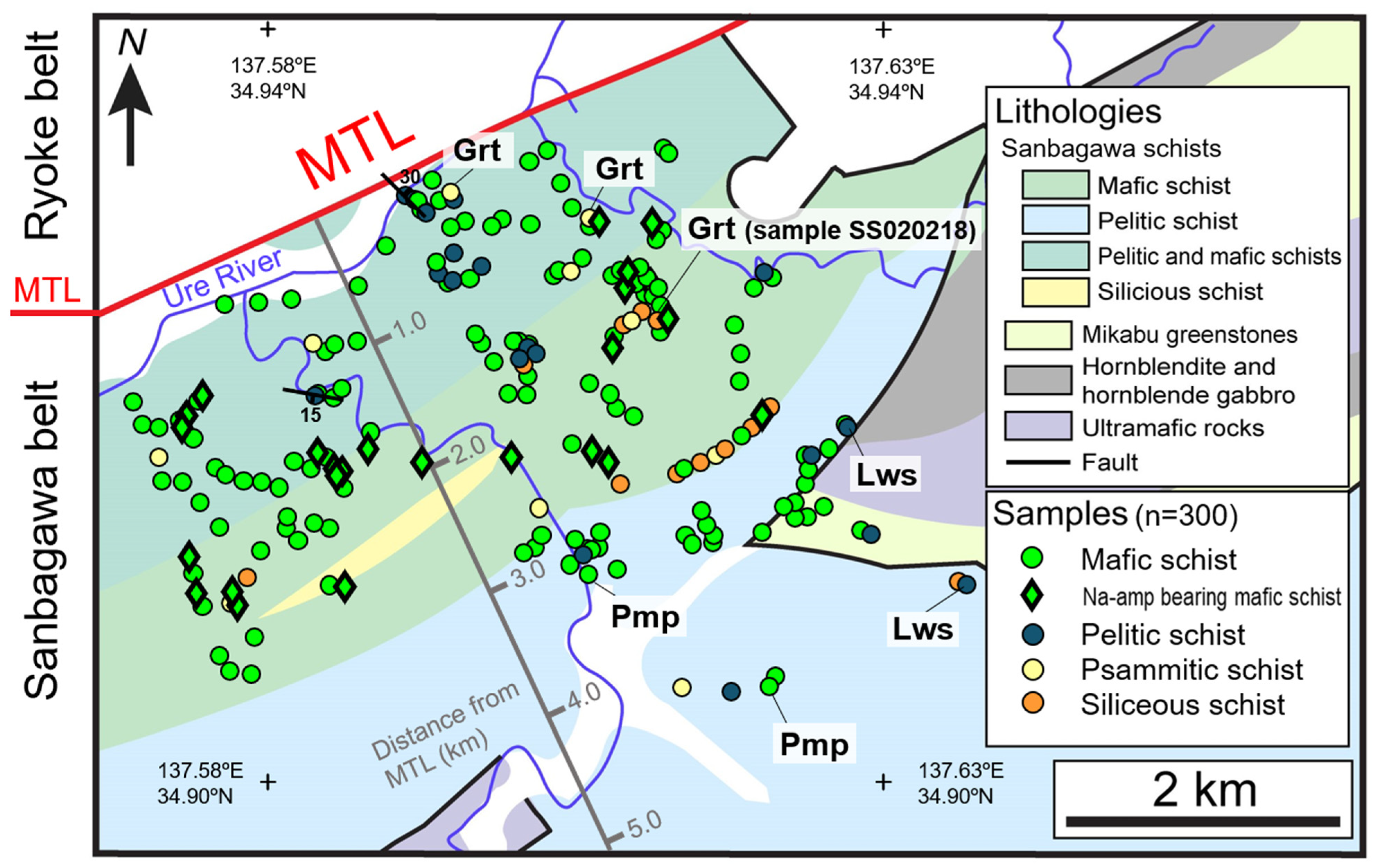

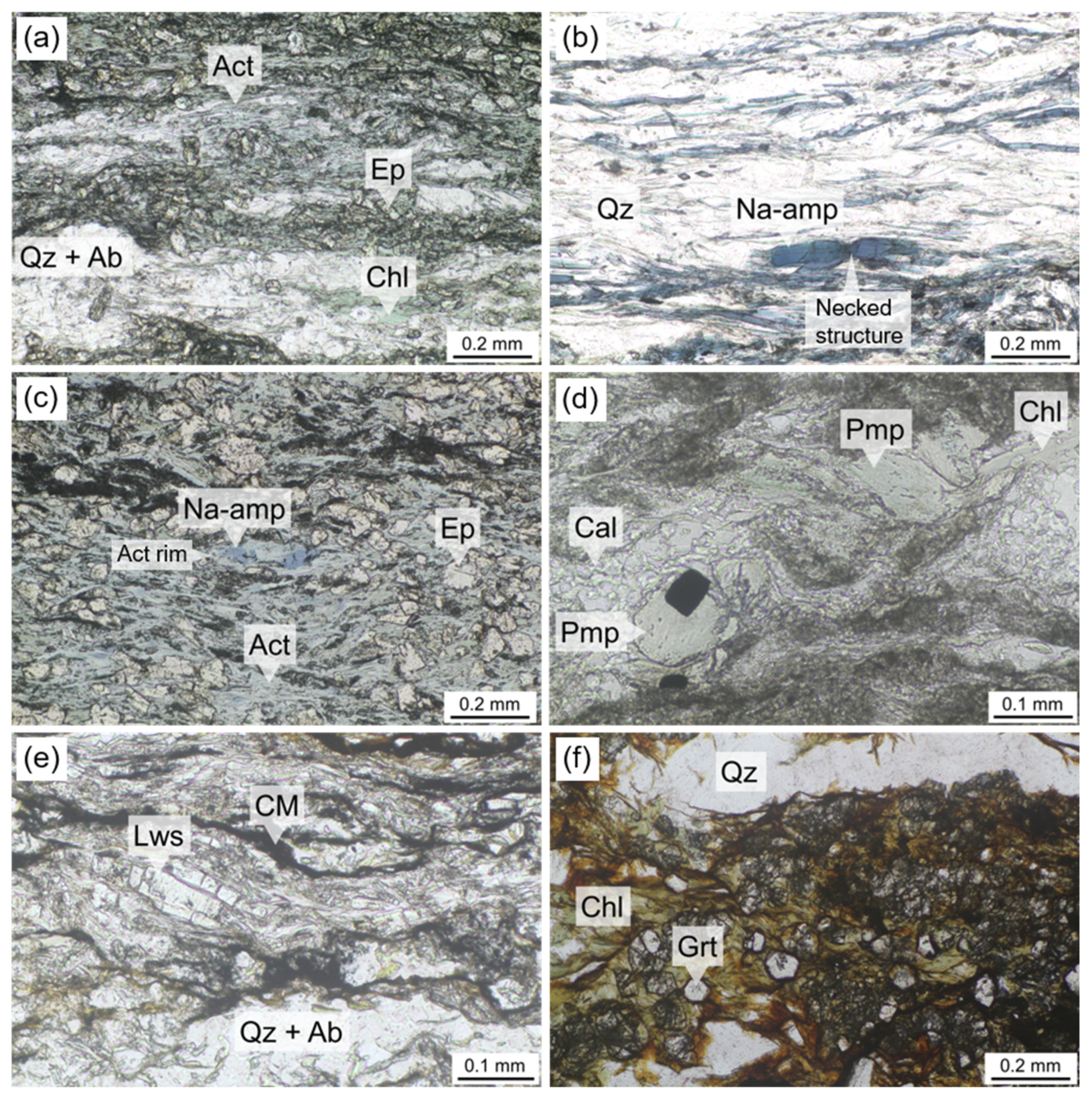
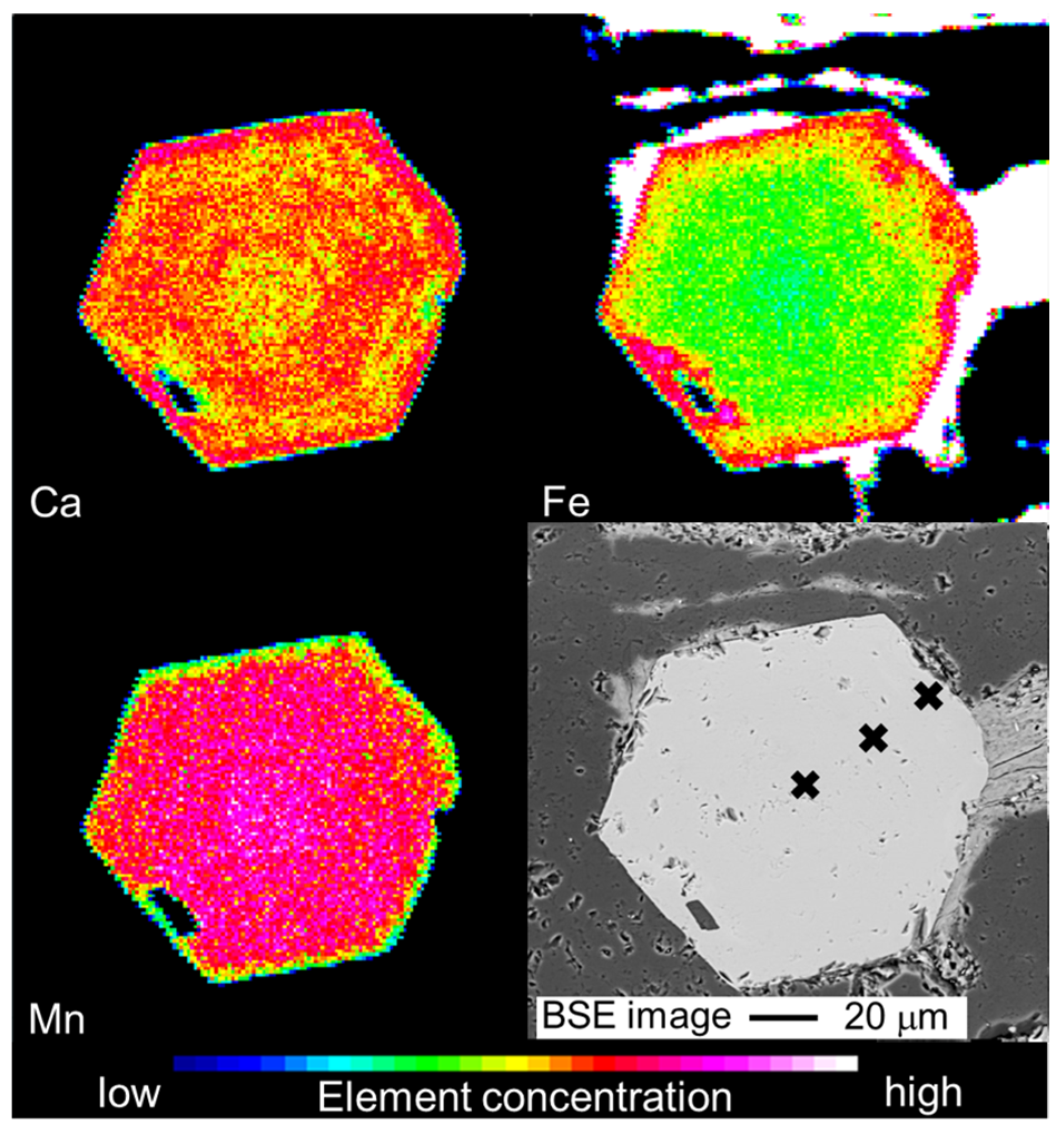
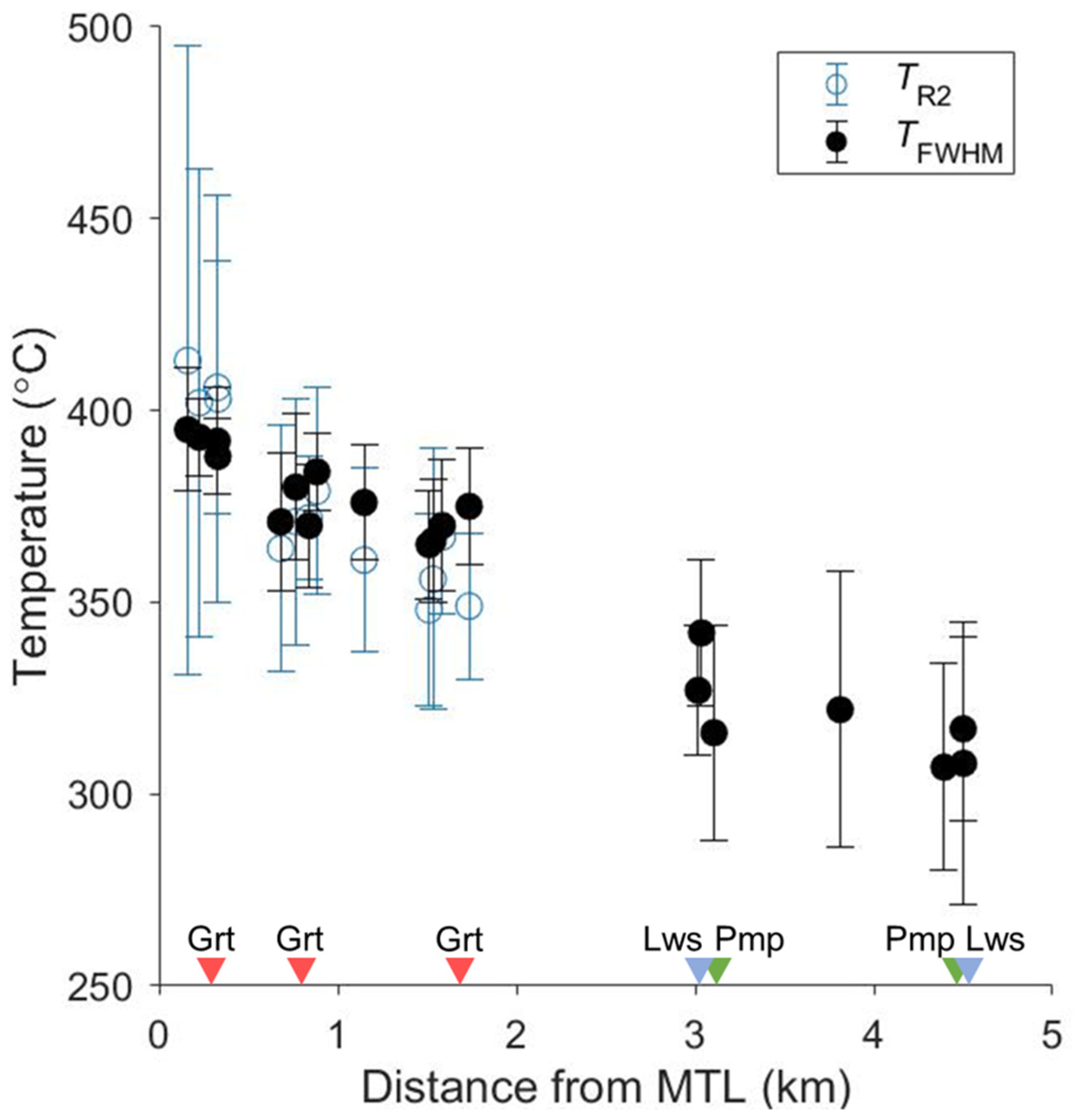

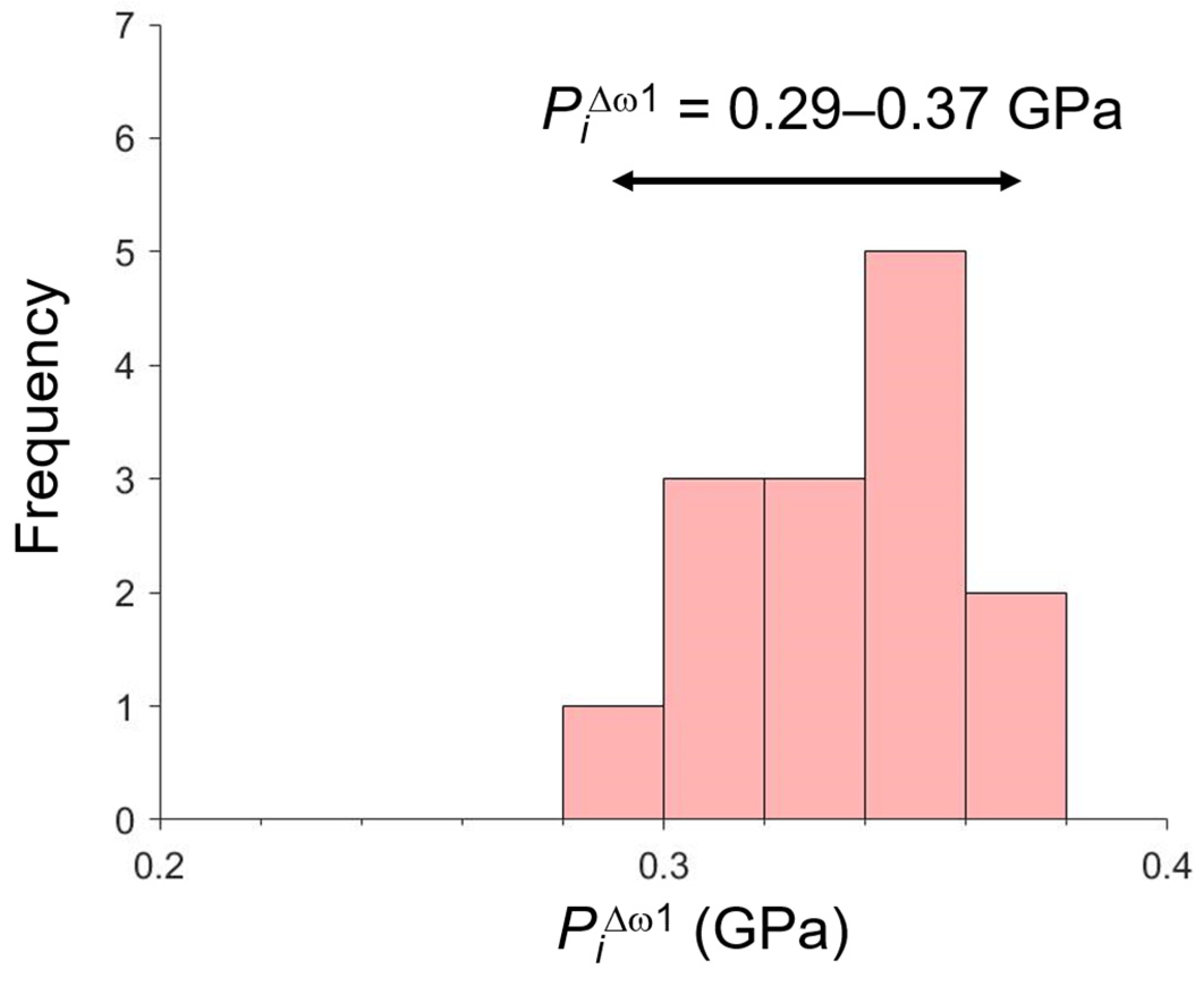
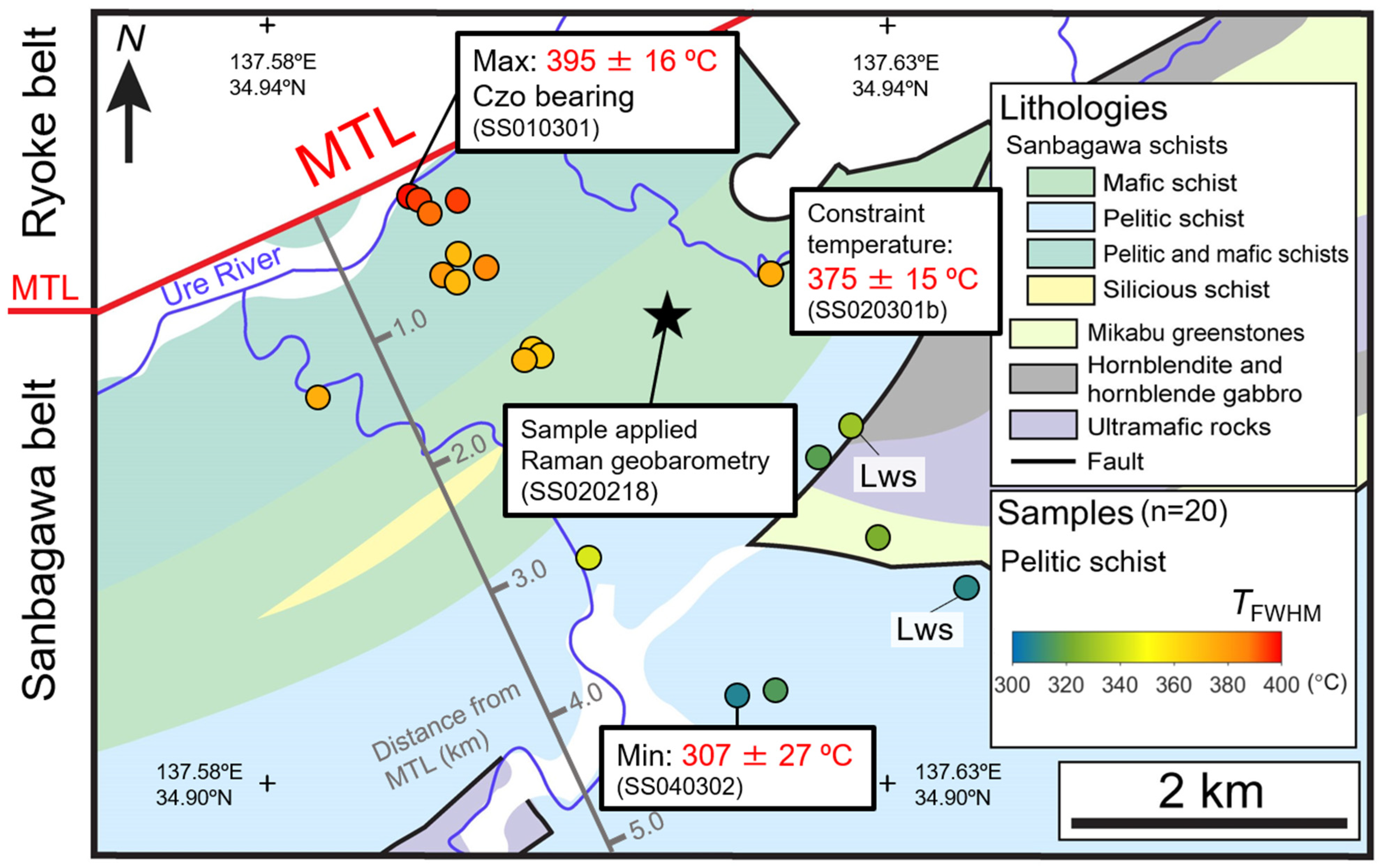
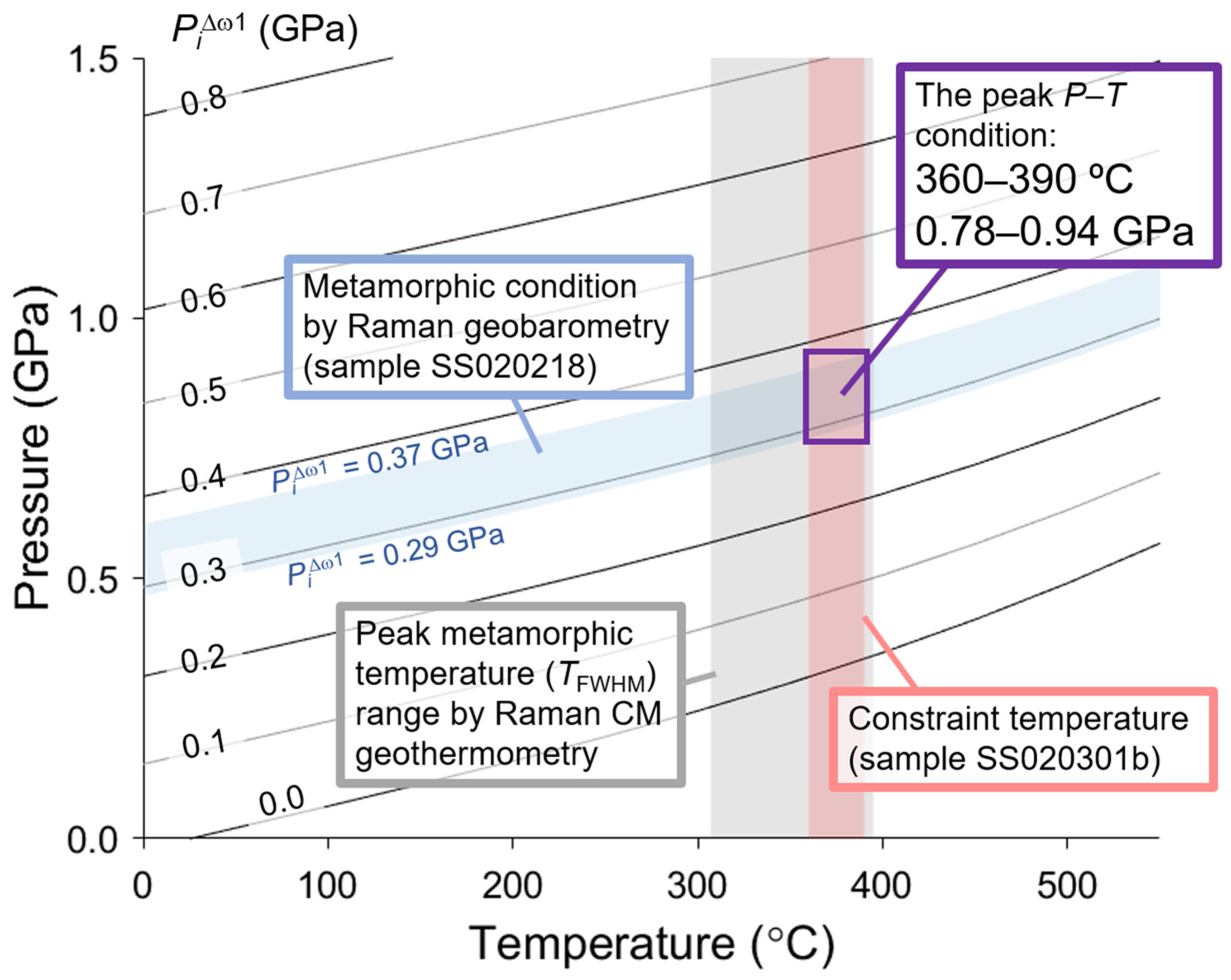
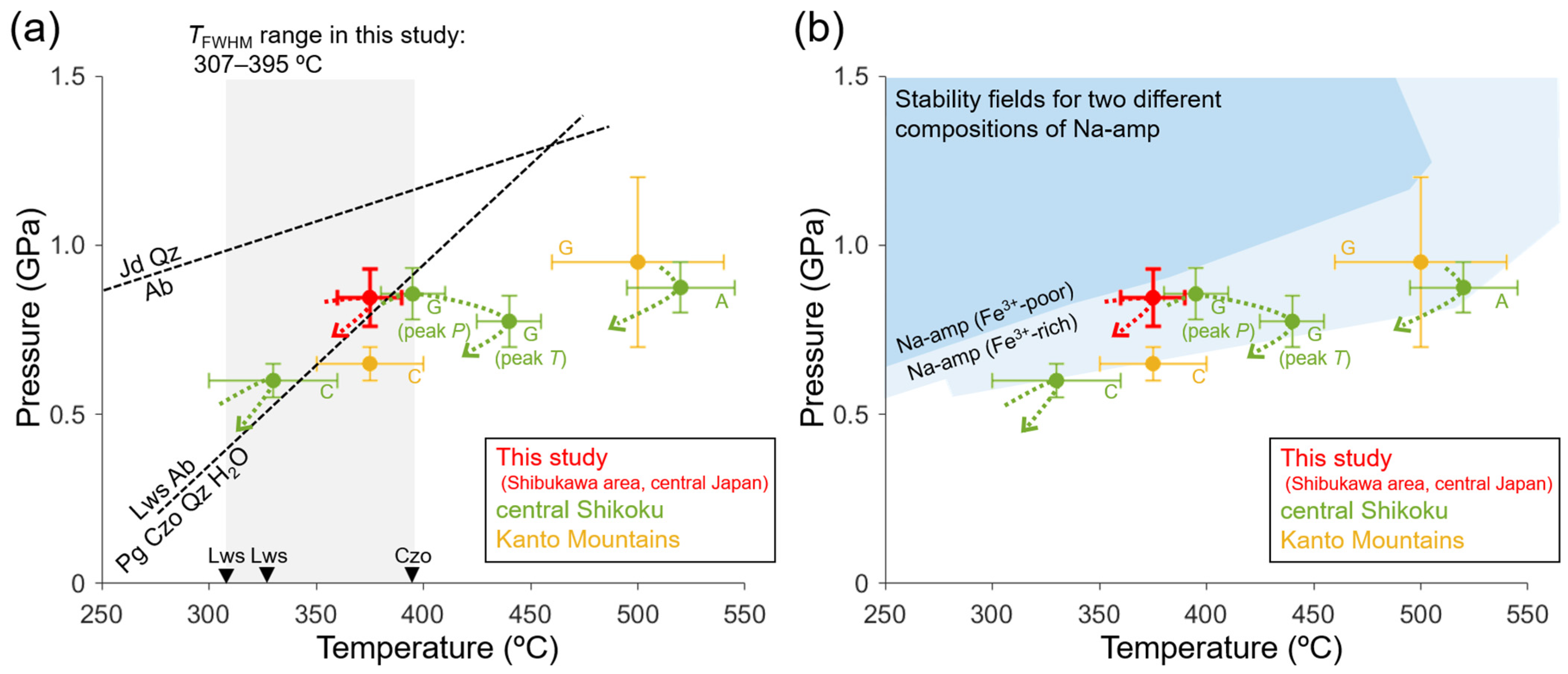
| Mineral | Spessartine | Spessartine | Spessartine |
|---|---|---|---|
| Sample | SS020218_Grt1-1 | SS020218_Grt1-2 | SS020218_Grt1-3 |
| Note | Core | Mantle | Rim |
| wt% | |||
| SiO2 | 35.17 | 35.58 | 35.99 |
| TiO2 | 0.30 | 0.30 | 0.16 |
| Al2O3 | 18.77 | 18.14 | 18.03 |
| Cr2O3 | 0.00 | 0.01 | 0.01 |
| FeO* | 3.36 | 4.15 | 4.88 |
| MnO* | 34.83 | 34.27 | 33.20 |
| MgO | 0.04 | 0.04 | 0.09 |
| CaO | 6.26 | 6.59 | 6.43 |
| Na2O | 0.01 | 0.03 | 0.01 |
| K2O | 0.00 | 0.00 | 0.00 |
| Total | 98.74 | 99.10 | 98.80 |
| Formulae | |||
| Si | 2.91 | 2.94 | 2.98 |
| Ti | 0.02 | 0.02 | 0.01 |
| Al | 1.83 | 1.77 | 1.76 |
| Cr | 0.00 | 0.00 | 0.00 |
| Fe2+ | 0.00 | 0.00 | 0.08 |
| Fe3+ | 0.23 | 0.29 | 0.26 |
| Mn2+ | 2.37 | 2.36 | 2.33 |
| Mn3+ | 0.08 | 0.04 | 0.00 |
| Mg | 0.00 | 0.00 | 0.01 |
| Ca | 0.56 | 0.58 | 0.57 |
| Na | 0.00 | 0.00 | 0.00 |
| K | 0.00 | 0.00 | 0.00 |
| Total | 8.00 | 8.00 | 8.00 |
| Sample | n | Distance from MTL (km) | TR2: Temperature from Equation (1) (°C) | TFWHM: Temperature from Equation (2) (°C) | Characteristic Minerals |
|---|---|---|---|---|---|
| SS010301 | 31 | 0.16 | 413 ± 82 | 395 ± 16 | clinozoisite |
| SS010302 | 32 | 0.22 | 402 ± 61 | 393 ± 10 | |
| SS010203 | 32 | 0.33 | 406 ± 33 | 392 ± 14 | |
| SS010304 | 39 | 0.33 | 403 ± 53 | 388 ± 10 | |
| SS010306 | 35 | 0.68 | 364 ± 32 | 371 ± 18 | |
| SS010308 | 32 | 0.77 | 371 ± 32 | 380 ± 19 | |
| SS010309 | 34 | 0.84 | 372 ± 16 | 370 ± 16 | |
| SS010310 | 33 | 0.88 | 379 ± 27 | 384 ± 10 | |
| SS010401 | 30 | 1.15 | 361 ± 24 | 376 ± 15 | |
| SS010105 | 34 | 1.51 | 348 ± 25 | 365 ± 14 | |
| SS010104 | 34 | 1.53 | 356 ± 34 | 366 ± 16 | |
| SS010102 | 38 | 1.58 | 367 ± 20 | 370 ± 17 | |
| SS020301b | 50 | 1.74 | 349 ± 19 | 375 ± 15 | |
| SS030202 | 30 | 3.02 | 327 ± 17 | lawsonite | |
| SS020401 | 30 | 3.04 | 342 ± 19 | ||
| SS030203 | 35 | 3.11 | 316 ± 28 | ||
| SS040201 | 45 | 3.81 | 322 ± 36 | ||
| SS040302 | 32 | 4.39 | 307 ± 27 | ||
| SS040301a | 32 | 4.50 | 317 ± 24 | ||
| SS040203 | 35 | 4.50 | 308 ± 37 | lawsonite |
Disclaimer/Publisher’s Note: The statements, opinions and data contained in all publications are solely those of the individual author(s) and contributor(s) and not of MDPI and/or the editor(s). MDPI and/or the editor(s) disclaim responsibility for any injury to people or property resulting from any ideas, methods, instructions or products referred to in the content. |
© 2025 by the authors. Licensee MDPI, Basel, Switzerland. This article is an open access article distributed under the terms and conditions of the Creative Commons Attribution (CC BY) license (https://creativecommons.org/licenses/by/4.0/).
Share and Cite
Tomioka, Y.; Kouketsu, Y.; Michibayashi, K. The Peak Metamorphic P–T Conditions of the Sanbagawa Schists in the Shibukawa Area, Central Japan: Application of Raman Geothermobarometry. Minerals 2025, 15, 724. https://doi.org/10.3390/min15070724
Tomioka Y, Kouketsu Y, Michibayashi K. The Peak Metamorphic P–T Conditions of the Sanbagawa Schists in the Shibukawa Area, Central Japan: Application of Raman Geothermobarometry. Minerals. 2025; 15(7):724. https://doi.org/10.3390/min15070724
Chicago/Turabian StyleTomioka, Yuki, Yui Kouketsu, and Katsuyoshi Michibayashi. 2025. "The Peak Metamorphic P–T Conditions of the Sanbagawa Schists in the Shibukawa Area, Central Japan: Application of Raman Geothermobarometry" Minerals 15, no. 7: 724. https://doi.org/10.3390/min15070724
APA StyleTomioka, Y., Kouketsu, Y., & Michibayashi, K. (2025). The Peak Metamorphic P–T Conditions of the Sanbagawa Schists in the Shibukawa Area, Central Japan: Application of Raman Geothermobarometry. Minerals, 15(7), 724. https://doi.org/10.3390/min15070724







